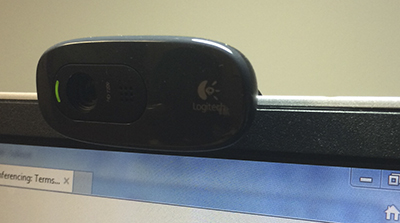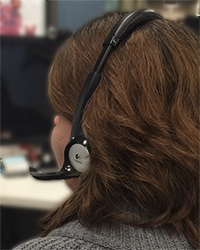Video Conferencing Technology
There are three necessary components to successful participation in a web conferencing classroom: the software, the camera and microphone, and the network connection. Let's explore each of them below.
Web Conferencing Software
There are numerous web conferencing software applications available and their use depends generally on the host's choice. This means if you want to use web conferencing, first check with your technology services to see if there is a preferred software or vendor. Popular applications include Zoom, Adobe Connect, Anymeeting, Blackboard Collaborate (previously Wimba and Elluminate), Cisco's Webex, Cisco's Jabber (formerly Movi), Citrix GotoMeeting, Microsoft Lync, Pexip, and Skype.
To get started, the host (usually the faculty) uses the web conferencing application to create a room. The software establishes a web address (URL) for the meeting. Participants join the meeting using the specified web address. In addition to live audio and video, the most important features include:
- File sharing
- Desktop/window sharing
- Polling
- Meeting recording
Zoom is a popular platform in academic settings, its use rising dramatically in spring of 2020 when the COVID-19 pandemic led to a fast implementation of online delivery of education in all academic settings nationwide. Your institution may have guidelines for using Zoom or other webconferencing tools, and there are many best practices and tips available online, including ways to keep your Zoom room secure and safe from "Zoom bombing" or simliar intrusions or breaches. Here is one site outlining tips from Harvard University's IT department.
Webcam and Microphone
 To participate fully in a web conference, participants must have a webcam and microphone. Laptops generally have a built-in camera, but if you are using a desktop computer, we recommend a USB camera—Logitech makes several really nice cameras that sell for under $100 (and some under $50). These cameras sit on top of the computer monitor and plug into any available USB port. These Logitech cameras also have an added benefit of software that allows you to record video or capture still photographs, so they can be used by faculty or students to record introductions or other multimedia.
To participate fully in a web conference, participants must have a webcam and microphone. Laptops generally have a built-in camera, but if you are using a desktop computer, we recommend a USB camera—Logitech makes several really nice cameras that sell for under $100 (and some under $50). These cameras sit on top of the computer monitor and plug into any available USB port. These Logitech cameras also have an added benefit of software that allows you to record video or capture still photographs, so they can be used by faculty or students to record introductions or other multimedia.
 Webcam microphones provide poor sound transmission for online classrooms because the sound dissipates; therefore, you should invest in a separate microphone. I recommend a headset because they are comfortable to wear and place the microphone at a good distance for speaking. The microphone boom is adjustable and can easily be moved out of the way if you are simply listening and watching rather than talking. Most headsets also have a mute button, which it essential for online courses.
Webcam microphones provide poor sound transmission for online classrooms because the sound dissipates; therefore, you should invest in a separate microphone. I recommend a headset because they are comfortable to wear and place the microphone at a good distance for speaking. The microphone boom is adjustable and can easily be moved out of the way if you are simply listening and watching rather than talking. Most headsets also have a mute button, which it essential for online courses.
Good netiquette demands that you mute your microphone while not actively speaking so that ambient noises—kids, dogs, the television, traffic, and even the sound of your own keyboard if you are taking notes—doesn't distract others on the conference. I have had great experiences with the Plantronics headsets and with Logitech.
Network Connections
The speed and quality of your connection can enhance or greatly detract from good experience in a web conferencing classroom. The network connection should be broadband, that is, a fast local area network, DSL, or cable. The connection should be capable of supporting a minimum of 256 Kbps download AND upload speeds in order send and receive live video without distortion. Satellite Internet connections have too much latency for dependable transmission. Latency is the delay between an occurrence and when you are aware of the occurrence; too much latency is what causes video transmissions to look all "boxy" and jiggly.
In the final content section about technology, let's do a brief tech tool roundup.
